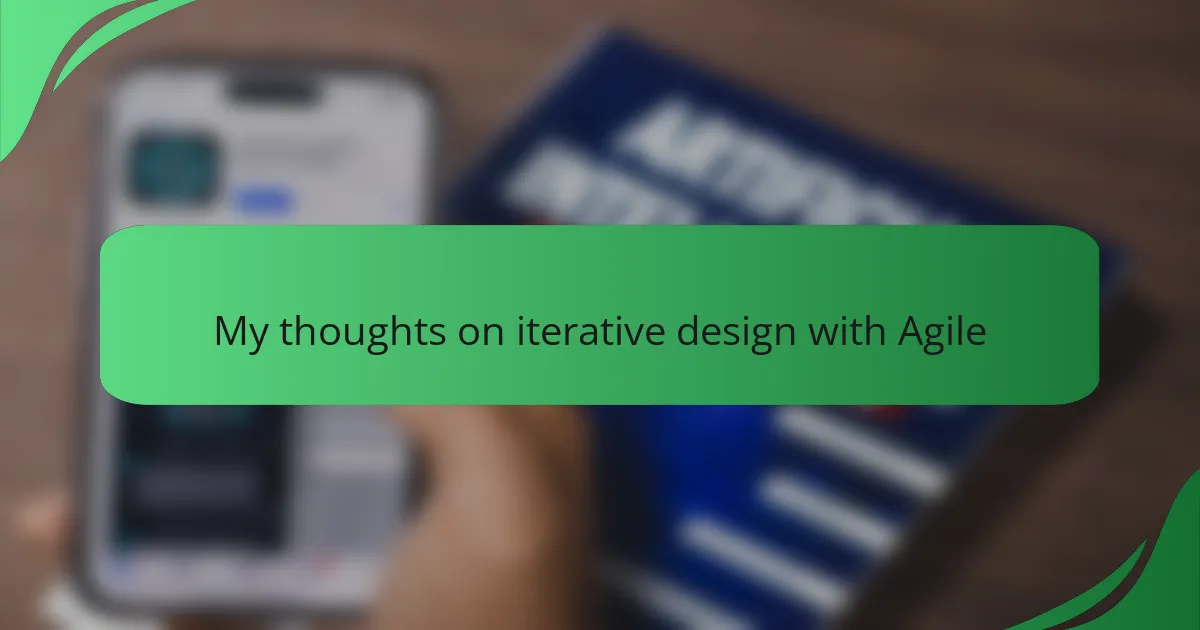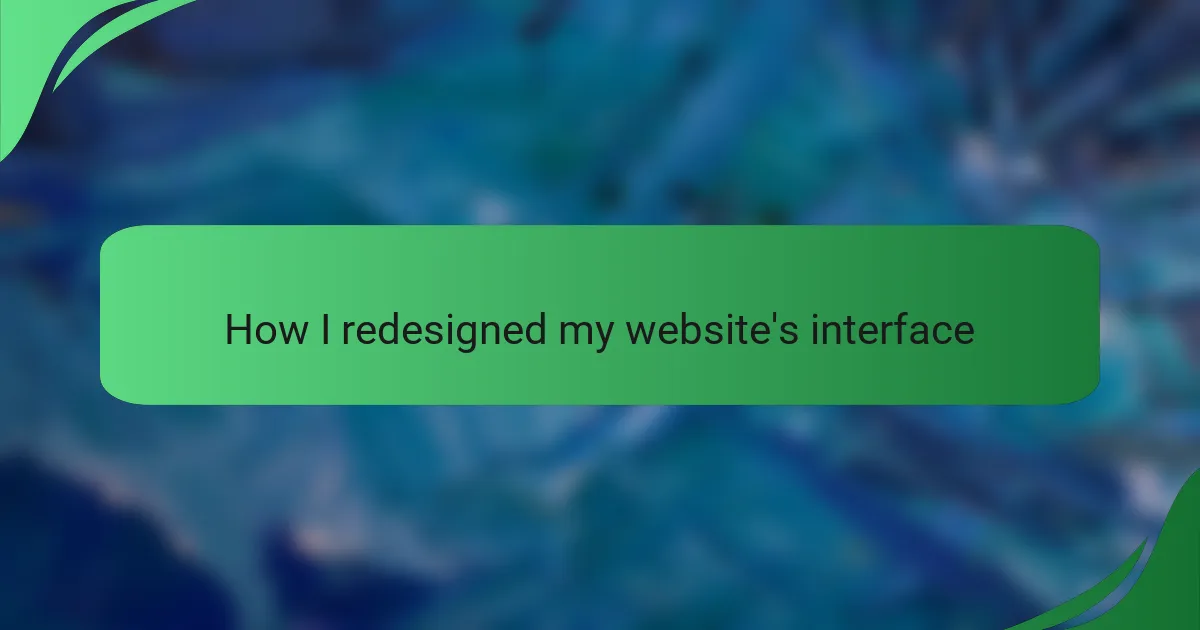Key takeaways
- Iterative design involves continuous refinement through cycles of prototyping, feedback, and adjustments, ensuring user needs are prioritized.
- Agile methodology emphasizes collaboration, flexibility, and regular user feedback, promoting meaningful improvements in design projects.
- User feedback is crucial for understanding real interactions, leading to enhanced product experiences and user loyalty.
- Embracing failure and fostering open communication within teams can lead to innovative solutions and a supportive design environment.
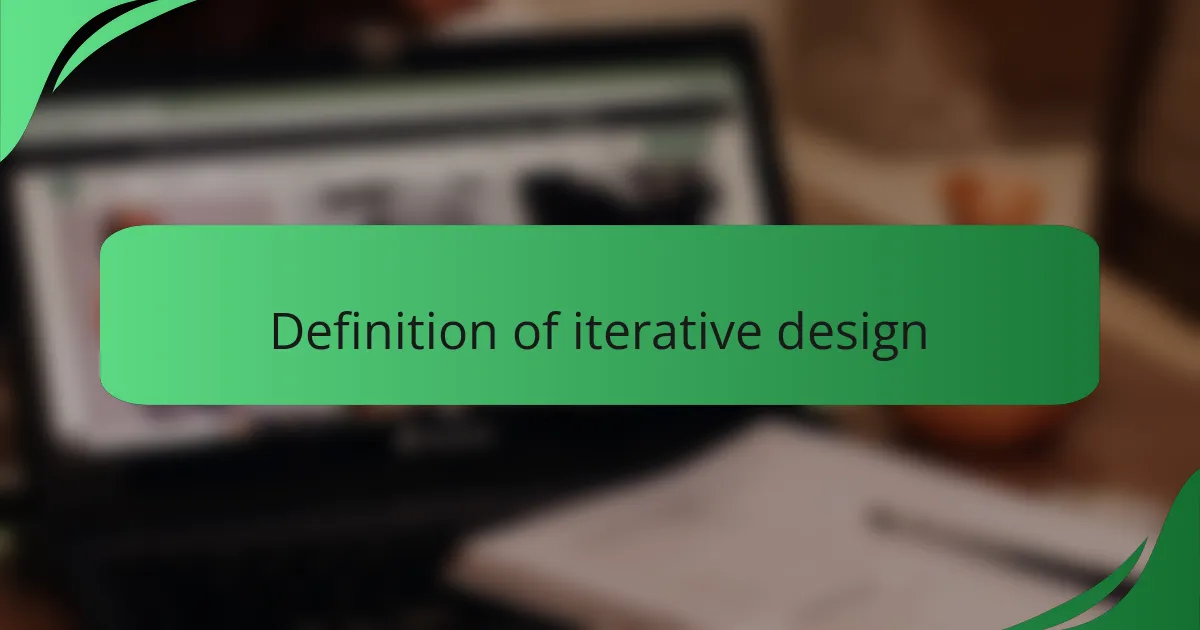
Definition of iterative design
Iterative design is a process where designers continuously refine and improve a product through repeated cycles, or iterations. Each cycle typically involves creating prototypes, gathering feedback, and making necessary adjustments. This repetitive nature allows for constant evolution, ensuring that the end result is more aligned with user needs and expectations.
I remember working on a project where the initial user feedback was surprising to me. It made me realize how vital it is to embrace iterative design; that initial idea can often be just the starting point. Have you ever experienced a situation where your first approach didn’t quite hit the mark? This method encourages us to adapt and grow, honing in on what truly resonates with users.
Ultimately, iterative design is about learning from each version of a design, leading to more effective and user-centric solutions. The beauty of this process lies in its flexibility and responsiveness. It’s a journey where every iteration brings valuable insights that can enhance the user experience dramatically.

Principles of Agile methodology
Embracing the principles of Agile methodology has been a game changer in my design projects. Agile prioritizes collaboration and flexibility, which means that team members must communicate frequently and be open to change. I remember a project where a sudden pivot in requirements led to a more user-friendly interface—proof that staying adaptable can yield remarkable results.
One of the core tenets of Agile is the emphasis on delivering working increments of the product regularly. This iterative approach allows teams to gather user feedback continuously, ensuring that each new version meets real-world needs. I’ve often found that the most meaningful insights come from these regular reviews, where users articulate their experiences—it’s like opening a treasure chest of ideas that can transform a project overnight.
Focusing on customer collaboration over strict contracts is another defining characteristic of Agile. In my experience, involving users early and often fosters a sense of ownership and investment in the design. Has there been a time when feedback you received not only changed your approach but excited you about the possibilities? Engaging users as partners in the process can lead to solutions that genuinely resonate with them.

Importance of user feedback
User feedback plays a crucial role in iterative design within the Agile framework. It helps teams understand how real users interact with their designs, providing insights that often go unnoticed in a sterile testing environment. I remember a project where initial designs seemed perfect to us, but user testing revealed unexpected navigation issues. That feedback helped us pivot quickly and make adjustments that significantly improved the overall user experience.
Engaging with users not only enhances the product but fosters a sense of ownership and connection. When users feel their opinions matter, it boosts their loyalty and satisfaction. I’ve witnessed firsthand how implementing feedback leads to innovations that are both functional and emotionally resonant with the target audience.
Here’s a simple comparison of traditional design vs. Agile iterative design regarding user feedback:
| Aspect | Traditional Design | Agile Iterative Design |
|---|---|---|
| User Involvement | Limited to initial phases | Continuous throughout the process |
| Feedback Timing | Post-launch | Ongoing, after each iteration |
| Adaptability | Inflexible once developed | Highly adaptable to user input |

Benefits of iterative design
Iterative design within Agile brings numerous advantages that significantly enhance the development process. One key benefit is the ability to incorporate user feedback continuously, which ensures the product evolves in alignment with real user needs. I’ve experienced firsthand how gathering insights after each iteration leads to more relevant features and overall satisfaction.
Another compelling aspect is the flexibility it offers. Changes can be made rapidly, allowing teams to pivot without extensive rework. In my experience, I’ve seen how this nimbleness can transform a project path, turning potential setbacks into swift adaptations that ultimately benefit the user experience.
Lastly, the collaborative nature of iterative design cultivates a strong teamwork environment. Regular check-ins foster open communication and shared goals. I often feel that collaboration sparks creativity, making the design process not just productive but also enjoyable.
| Benefit | Description |
|---|---|
| User Feedback Integration | Enables continuous improvement by aligning design with user needs. |
| Flexibility in Design Changes | Allows quick adaptations, reducing wasted effort and enhancing relevance. |
| Enhanced Collaboration | Fosters teamwork and innovation through regular communication and shared objectives. |
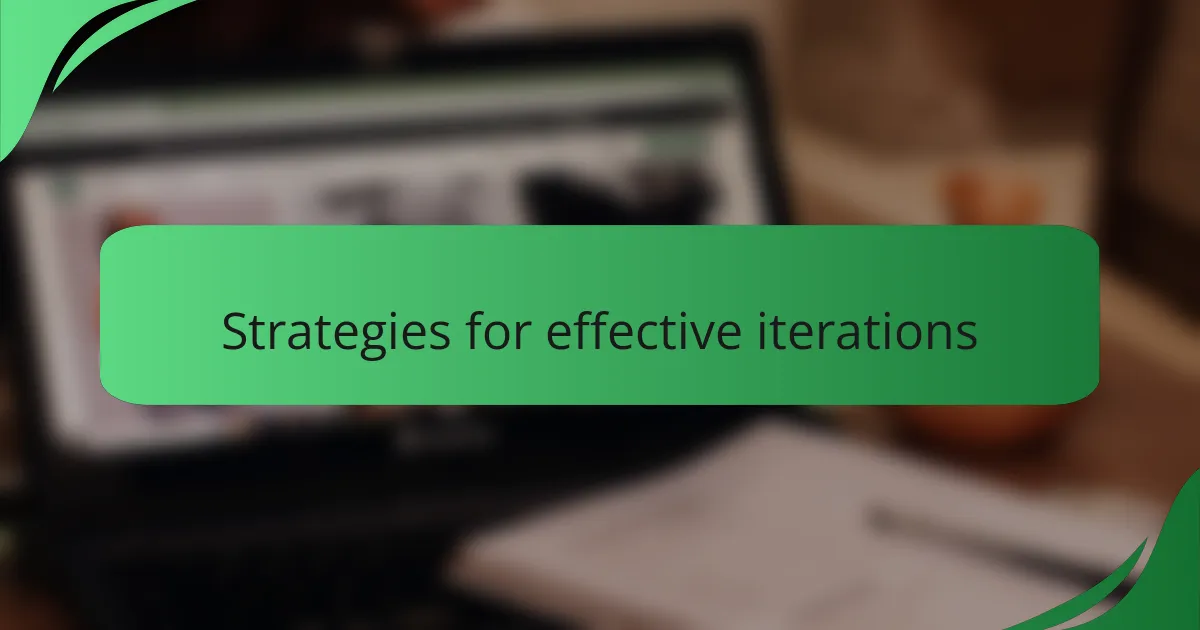
Strategies for effective iterations
When it comes to effective iterations, setting clear goals for each cycle is essential. I’ve learned that defining what success looks like for each iteration helps keep the team on track. For instance, during a recent redesign, we specified measurable outcomes for user engagement. This focus not only guided our efforts but also showed us where we needed to adapt—what a relief when the metrics indicated progress!
Another strategy I recommend is involving cross-functional teams in the iteration process. I recall working with developers, designers, and marketers all in the same room, brainstorming ideas based on user feedback. This collaboration enriched our solution and illustrated the importance of diverse perspectives. Have you seen how different disciplines can spark new ideas? It’s truly powerful!
Lastly, don’t underestimate the role of documenting lessons learned after each iteration. I’ve made it a habit to jot down what worked and what didn’t, which has proven invaluable in future projects. Reflecting on these past experiences creates a roadmap of improvement. It’s like collecting pearls of wisdom over time, wouldn’t you agree?

My personal experiences with Agile
In my journey through interface interaction design, Agile has been a game changer. I remember one project where we embraced iterative design cycles. We saw immediate improvements based on user feedback, and it was invigorating to witness our designs evolve rapidly.
One of the most rewarding aspects of Agile is the constant collaboration. I recall brainstorm sessions that sparked innovative ideas, ultimately leading to more intuitive interfaces. It felt like we were crafting something exceptional together, which made the long hours worthwhile.
Through my experiences, I learned that flexibility is vital. Adapting to change became second nature, and I found it exciting to pivot our approach based on real user interactions. This adaptability helped foster a stronger connection between our team and our target audience.
| Aspect | Agile Design |
|---|---|
| Feedback Integration | Rapid adjustments based on user input |
| Collaboration | Encourages teamwork and shared ideas |
| Flexibility | Adaptable approaches to evolving needs |
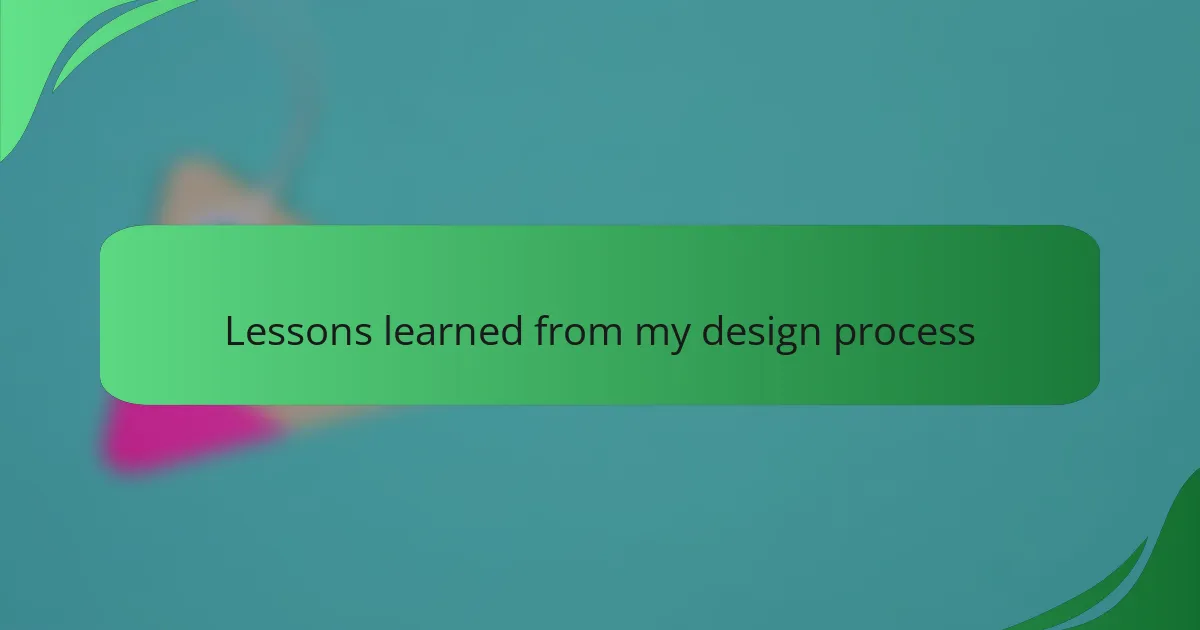
Lessons learned from my design process
Throughout my design process, one key lesson I’ve learned is the importance of embracing failure as a stepping stone to success. I vividly recall a time when a design I was proud of completely missed the mark during user testing. Rather than feeling defeated, I chose to view this feedback as an opportunity to rethink my approach. This experience taught me that every misstep carries valuable insights that can inform future iterations.
Additionally, I’ve discovered that fostering open communication within my team is crucial. I remember a project where regular check-ins became our lifeline; we exchanged ideas freely and quickly identified challenges. This collaborative spirit not only accelerated our workflow but also built a sense of trust and camaraderie. Have you ever noticed how a supportive team environment can fuel creativity? It’s truly transformative.
Lastly, I’ve come to appreciate the significance of user empathy in my design process. Engaging with users on a personal level revealed their pain points and aspirations, shaping our iterations in meaningful ways. I once spent a day shadowing users as they interacted with our prototype. This experience opened my eyes to their struggles and highlighted the importance of designing with genuine understanding. How often do we pause to step into our users’ shoes? It makes a world of difference.
